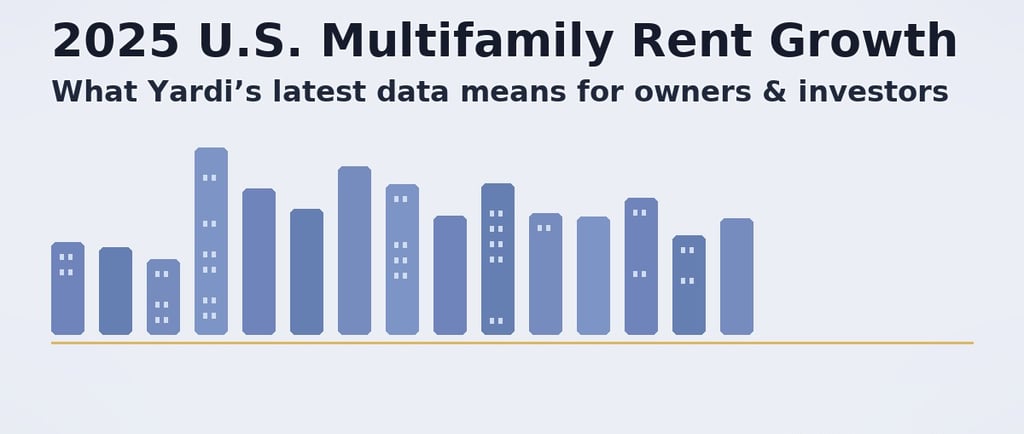2025 U.S. Multifamily Rent Growth: Yardi Matrix Insights for Investors
See the latest Yardi Matrix data on rents, occupancy, and build-to-rent in 2025—plus practical strategies to protect NOI and underwrite acquisitions.
Published by E&S Properties
10/1/20256 min read


U.S. Multifamily Rent Growth 2025: What the Latest Yardi Matrix Data Means for Owners, Operators, and Investors
The newest read on U.S. multifamily fundamentals shows a market that’s steady—but still sorting through a heavy supply cycle and a slower macro backdrop. Drawing on Yardi Matrix data summarized by Multi-Housing News, here’s how rents, occupancy, and single-family build-to-rent (BTR/SFR) performed through August 2025—and what practical moves you can make right now to protect NOI and position for the next leg of the cycle. 2025 Rent Growth.
Headline Takeaways
National asking rents are essentially flat to slightly positive. The average advertised asking rent eased $1 in August to $1,755, with year-over-year growth of 0.7%, a modest deceleration from mid-summer. Occupancy held at 94.7% in July, unchanged year-over-year.
BTR/SFR continues to outprice conventional multifamily. Average advertised asking rents for single-family build-to-rent reached a new record $2,208 in August (up 0.6% YoY), underscoring the durability of demand for “for-rent” detached and townhome product.
Regional divergence is real. Earlier 2025 readings showed New York City (+5.5%), Chicago/Kansas City (+3.7%), Columbus (+3.5%), and Philadelphia (+3.2%) leading rent growth, while Austin (-5.4%), Denver (-3.6%), and Phoenix (-3.0%) lagged amid outsized new supply.
Occupancy is near a cycle low but stable. With hundreds of thousands of units still delivering, national occupancy has hovered in the 94.4%–94.7% range for months—low by last decade’s standards, but steady enough to keep revenue growth slightly positive where concessions are disciplined.
The Arc of 2025 So Far
The year opened with a small but welcome break from the late-2024 soft patch: January rents ticked up $3 to $1,746, February edged up to $1,751, and March reached $1,755, taking YoY growth to ~1%. Spring readings were choppier as deliveries crested and some Sun Belt metros repriced to clear lease-ups, but by mid-summer the theme was “steady as she goes”: July averaged $1,754 (+0.7% YoY), and August gave back $1 while holding the YoY line at 0.7%. The through-line is consistency—not acceleration.
Occupancy tells the same story: mid-94% prints have persisted despite record supply, with July at 94.7% and prior months bouncing between 94.4%–94.6%, depending on the dataset month. That’s the “new normal” until the construction pipeline thins or net absorption re-accelerates.
On the BTR/SFR side, advertised asking rents stayed above $2,150 all year and marched to $2,208 by August. While YoY growth rates are modest (generally 0–1%), rent levels remain a premium to conventional apartments, reflecting the household preference for more space, garages, and townhome-style layouts—especially in suburban submarkets.
Why the Spread Between Markets Is Widening
Yardi’s metro detail shows what owners on the ground already know: supply intensity drives outcomes. Markets layering 5%+ new inventory relative to stock experienced the sharpest pricing pressure (Austin, Denver, Phoenix), as lease-up velocity required concessions and measured rent resets to win heads-in-beds. Conversely, gateway and Midwestern markets with constrained new starts or structural demand underpinnings (NYC, Chicago, Philadelphia, Kansas City, Columbus) posted resilient, sometimes robust, rent growth.
Three forces explain the divergence:
Deliveries vs. absorption timing. National absorption improved from late-2024, but in high-supply metros, deliveries still outpaced move-ins. That mismatch erodes pricing power even if demand is healthy in absolute terms.
Mortgage lock-in and for-sale affordability. Ownership remains expensive relative to renting, which supports renter demand nationally. But in oversupplied nodes, greater choice for renters means more aggressive concessions to stabilize occupancy—flattening effective rents.
Job growth mix. Markets with diversified, services-heavy job bases (and less cyclical exposure) are better at powering steady in-migration and household formation, keeping the rent roll stable even without eye-popping growth.
What This Means for Owners and Operators
1) Price precisely, not aggressively.
In a 0.5%–1.0% YoY rent-growth world, mispricing by $50–$75 is the difference between 30-day downtime and 7-day turns. Use daily pricing and lease-expiration spreads to smooth seasonality. Where comps are rolling out two months free at lease-up, match the net effective outcome without training residents to expect perpetual discounts. (The national data underscores how thin rent growth is; every basis point of occupancy matters.)
2) Fight vacancy, not rents.
At ~94.5% national occupancy, pushing street rents $25 while letting days vacant creep higher will likely reduce revenue. Lean into renewal capture (3–5% ask, deal to 1–3% depending on unit quality), turn-time targets (aim for <7 days), and pre-marketing units 14–21 days before availability. The macro data suggests stability—not froth—so revenue wins come from blocking and tackling.
3) Invest in the unit features residents will pay for in a tight spread environment.
BTR/SFR’s premium points to what renters value: private entries, extra storage, pet-friendly design, work-from-home space, and package logistics. Even in mid-rise assets, you can capture some of that value with smart-home packages, sound attenuation, flex rooms, and locker-based parcel systems. The BTR rent premium (>$2.2k in August) is a directional signal for amenity ROI.
4) Re-underwrite expenses like it’s 2025, not 2019.
With top-line growing sub-1% and insurance, payroll, and repairs running hot, NOI protection flows from expense realism and procurement discipline. Budget insurance at current quotes, not trailing, and ring-fence maintenance with multi-property contracts. The national numbers won’t bail out an optimistic expense line.
5) Asset management cadence: monthly micromoves, quarterly strategy.
Given how flat national growth is, read the weekly tour-to-app funnel, run loss-to-lease audits monthly, and re-cast your concession roll-off each quarter. In high-supply metros, plan for slower lease-up and longer stabilization by design—then beat those assumptions with operational sharpness.
Guidance for Buyers and Sellers
For buyers:
Favor submarkets with controlled pipelines. The metro-level splits (NYC/Chicago/Philly outperformance vs. Austin/Denver/Phoenix softness) are, at root, supply stories. If you’re underwriting five-year holds, insist on granular pipeline mapping (deliveries by lease-up radius, not just metro aggregates).
Model rent growth at 0–1% for 24–36 months in high-supply zones, and stress test occupancy to 94% with lease-up concessions. For stabilized coastal or Midwest core, you can justify 1–2% with lower variability.
Debt matters as much as the deal. In a flat rent environment, interest expense is your P&L swing. Lock rate caps and match amortization to hold period; do not rely on refi optionality as your primary value driver.
For sellers:
Stabilize first, then sell. With buyers underwriting conservatively, the cleanest route to price is clean T-12s—tight variance, low delinquency, and clear concession burn-off.
Show, don’t tell, the demand story. Package tour data, renewal metrics, and lead sources. In a market where national growth rounds to 1%, proof of marketing efficiency and retention pushes cap-rate bids your way.
Development and the BTR Signal
The BTR/SFR read—$2,208 average in August, up 0.6% YoY—is instructive for developers and value-add sponsors alike. Households will pay for space and privacy, even if headline growth is muted. That has three implications:
Suburban garden/townhome hybrids win. If you can’t build pure BTR, emulate it: direct entries, fenced patios, attached/assigned parking, and in-unit storage. The rent premium in BTR suggests you’ll capture higher effective rents and lower turnover with these features.
Phased deliveries help lease-up math. In supply-heavy metros, avoid flooding your own submarket. Phasing improves pricing power and allows marketing learnings to compound.
Amenity ROI beats amenity lists. Prioritize noise control, Wi-Fi infrastructure, pet amenities, and package logistics over trophy features that inflate OpEx.
The 6 Moves to Defend NOI in a 0–1% Growth Year
Precision renewals: Automate renewal offers with bands (e.g., +1–3% for A/B units, flat to +1% for C) tied to in-place vs. market spreads and unit-level demand.
Turn-time SLAs: Inspect day 0, vendor dispatch day 1, make-ready complete day 5, QA day 6, on market day 7. Track days vacant with the same intensity as rent growth.
Funnel instrumentation: Weekly traffic → tour → app → lease reviews with source-level ROAS. Reallocate marketing spend monthly.
Concession governance: Centralized approval for anything over 2–4 weeks; require defined roll-off and recapture plans.
Expense playbooks: Portfolio contracts for landscaping, pest, turns, paint; quarterly insurance bid reviews; preventive maintenance to cut emergency calls.
CapEx that cash-flows: Focus on in-unit W/D, sound attenuation, LED + smart thermostats, and package lockers—items that reduce OpEx or raise EGI measurably.
These moves aren’t glamorous, but in a thin-growth year they separate middling performers from top-quartile operators.
What to Watch Next
Pipeline burn-off. As 2024–2025 deliveries are absorbed, supply pressure should abate into 2026, especially where starts slowed sharply. Expect occupancy to grind higher before headline rent growth re-accelerates.
Sun Belt stabilization. Watch lease-up pace, concession roll-offs, and traffic conversion in Austin, Denver, Phoenix, and peers. The first signal of turn comes from concessions shrinking rather than street rents jumping.
BTR durability. If BTR keeps a $400–$500 premium to conventional product and maintains mid-94% occupancy, expect more investors to rotate toward townhome-style and low-density infill where land basis and impact fees pencil.
Bottom Line
This is a blocking-and-tackling phase for multifamily. The national picture—asking rents around $1,755, YoY growth near 0.7%, occupancy in the mid-94s—isn’t bad; it’s just not doing any heavy lifting for you. Winners in 2025 will price smartly, protect occupancy, and sweat operations while underwriting with flat-to-modest rent growth. If you’re buying, favor pipeline-light submarkets and capital structures that don’t depend on cap-rate magic or a quick refi. If you’re operating, the play is clear: own the funnel, own the turn, own the expense line. When the supply bulge passes—and it will—your assets will already be positioned at higher NOI run-rates, ready to capture the upswing.
Source: Multi-Housing News summary of Yardi Matrix market surveys through August 2025.
🔎 Ready to take the next step?
📩 Sign up for our newsletter to get weekly insights on current trends.
📝 Interested in investing? Complete our investor questionnaire and we’ll be in touch with opportunities that match your goals.
